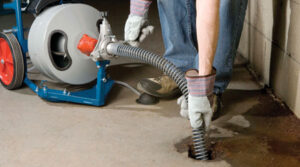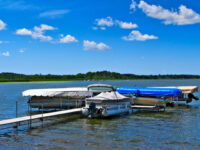Drain Cleaning: How to Get Rid of Clogged Drains
People spend a lot of time cutting their lawn just right and treating it for bugs, but drain cleaning is often neglected. Clogged drains can cause serious problems for your home and health.
Drain flies love laying their eggs in sludge, and clogged drains can reveal bacteria that can affect your family’s health. Keeping up with drain cleaning can prevent these problems and save you money. For professional help, contact Plumber Montgomery TX now!
Chemical drain cleaners are a common sight in many homes’ cleaning cabinets. They work by creating a chemical reaction with the clogged substances in your pipes. These cleaners typically have a thick liquid or foam formulation that is heavier than water and passes through the blockage to reach it. They usually contain sodium hydroxide (lye) or potassium hydroxide (KOH) to transform grease into soap and thioglycolic acid to dissolve hair. They may also contain aluminum to produce bubbles of hydrogen gas to clear the clog.
Most of these chemical drain cleaners work best on organic clogs such as food, hair, or grease. They are readily available at hardware, home improvement, and big-box stores in liquid or gel form.
These cleaners are not only dangerous to humans but poisonous to the environment as well. They often release toxic fumes that irritate the nose, eyes, and throat. If used incorrectly, they can also corrode your pipes. Once poured down the drain, they can seep into groundwater and contaminate soil and waterways. Even unused drain cleaners that are stored in plastic bottles can cause environmental damage as they can leach into the groundwater supply.
When these chemicals come into contact with water, they can degrade plastic pipes and erode metal ones. They also generate heat that can soften PVC piping and cause it to leak. The resulting holes can allow dirt and debris to enter the pipe, leading to more serious problems.
Another issue with chemical drain cleaners is that they aren’t very effective. They can remove some hair and grease clogs, but they rarely dislodge solid obstructions such as tree roots. Most of the time, they simply push the clog further down the pipe.
The most harmful aspect of chemical drain cleaners is that they are unsafe for your pipes. They can corrode older pipes and make them weaker and more vulnerable to cracks and breaks. They can also contaminate the environment and contribute to smog. Chemical drain cleaners are a threat to plants and animals that live in and around bodies of water, as they often seep into groundwater and bodies of water or enter the air during production and disposal.
Plungers
A clogged drain or toilet is one of the most frustrating problems that can confront homeowners. It is often easy to resolve if you have the right tools. A plunger is a simple, inexpensive tool that can save the day when other methods fail. But you must use it correctly to get the best results.
There are a variety of plungers on the market, from standard models that have a small cup at the end of an accordion-like base to flange plungers that have extra material shaped to fit the drain. The size and quality of the plunger you choose depend on where and how it will be used. For example, a flange plunger is more effective on toilets than smaller ones, and it works best on widening rather than narrowing drains.
When using a plunger, make sure that the flat cup of the plunger is properly positioned over the drain opening and that enough water covers it to create a seal. Then thrust down and up, keeping the cup firmly in place, for about 20 seconds. The resulting suction may break up the clog and allow water to flow freely again.
If plunging doesn’t work, try a chemical drain cleaner. These liquids or foam formulations are heavier than water and therefore pass more quickly through the pipes to reach the clog. They usually contain ingredients like potassium hydroxide to transform grease into soap and thioglycolic acid to dissolve hair. While these products are fairly safe to use, they can burn skin and damage clothing if splashed. They can also cause the release of noxious fumes and may require a special safety mask.
Homeowners can find these and other commercial clog-clearing products at hardware stores, but they must always use them at their own risk. If these chemicals irritate the skin or eyes, or if they are absorbed into the body through the skin or respiratory tract, medical help should be sought immediately. Similarly, mechanical devices such as drain snakes and hand augers can do serious harm if they are used improperly.
Biological Cleaners
Unlike caustic cleaners, which can be extremely hazardous to your health (if they come into contact with your skin and also if you inhale their fumes), biological drain cleaners are completely safe to use. They contain enzymes and bacteria that naturally decompose organic materials like hair, grease, soap film, and more. These cleaners are also safer for your pipes, as they don’t corrode them the way caustic cleaners do. However, this type of drain cleaner can take quite a while to work on a blockage.
There are different types of biological cleaners, including liquids and powders. Liquid biological cleaners are usually easier to apply, as they can be poured directly into the affected drain or pipe. These cleaners tend to have a shorter shelf life than dry powders, though.
Both of these types of drain cleaners are completely biodegradable, so they don’t pose any threat to your pipes or the environment. They can be used on most any type of drain, including toilets, showers, sinks, and tubs. They are also safe for kids and pets, and they don’t leave any chemical residue behind.
However, these kinds of cleaners don’t really help with inorganic clogs (e.g., from a broken pipe or sewer backup). If the problem is caused by something that can’t be dissolved with organic materials, a mechanical approach (e.g., a plumber’s snake or auger) may be necessary to break up the clog.
As an alternative to caustic drain cleaners, consider using enzymatic drain cleaners, which contain bacteria and enzymes that break down waste and dissolve blockages. These products are less corrosive than chemical cleaners, and they can be just as effective at unclogging your pipes. You can also buy bacterial cleaners that are specifically designed for home use, are safe to apply, and won’t damage your pipes or the environment. These types of drain cleaners are more cost-effective than chemical ones, and they can be a great alternative to toxic chemicals. Just be sure to follow the directions carefully! If you’re not sure what type of drain cleaner is right for you, ask a professional!
Hot Water
This is an old-fashioned trick that works well on grease or soap clogs. Stir together in a large measuring cup 1/2 cup each of table salt and baking soda, then pour the powder down the dry, clogged drain. Let it sit for anywhere from 45 minutes to overnight, depending on the severity of the clog. Then, slowly pour a kettle of boiling water down the drain (use hot tap water if you have PVC pipes). It’s a good idea to wear rubber gloves for this step. The resulting fizzing action should break up and flush away the clog. Repeat as needed until the drain runs freely.
Many clogs develop in kitchen sinks because of fats and oils that solidify as they cool. Using a pot of hot water can help dissolve these hardened substances and wash them down the pipes, says Lynn Redmile, a product review analyst at the Good Housekeeping Institute. Just be sure to use boiling water (212 degrees Fahrenheit) to avoid damaging plastic or porcelain sinks and causing a pipe leak.
Another option is to pour a combination of vinegar and baking soda down the drain. This is an inexpensive DIY drain cleaner that can work on most clogs, notes the blog Bonzai Aphrodite. Start by pouring a half cup of baking soda down the drain, then add one-fourth cup of white vinegar. It will likely fizz and bubble, so be prepared to plug the drain or cover the opening with a towel for protection against splashing. After the mixture has sat for 15 minutes, pour in several cups of boiling water. If the clog persists, try the mixture again, adding more baking soda and vinegar to increase the strength of the solution.
If you can’t resolve a stubborn drain clog with the methods above, it may be time to call in the big guns. Be careful with chemical drain cleaners, as they can eat through pipes and lead to costly repairs. If you do use chemicals, follow the manufacturer’s instructions and use them sparingly. Also, always check the label to be sure that the product is safe for your pipe materials.






